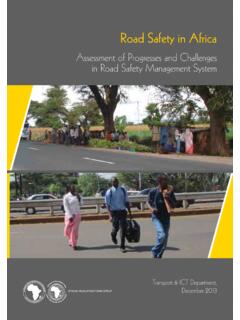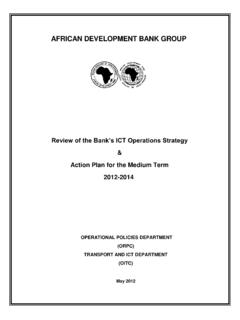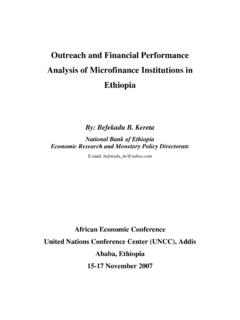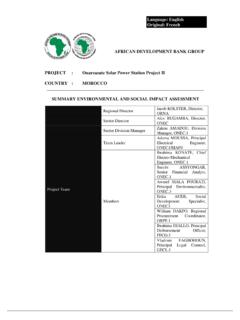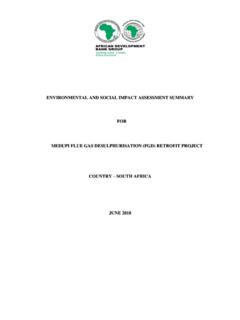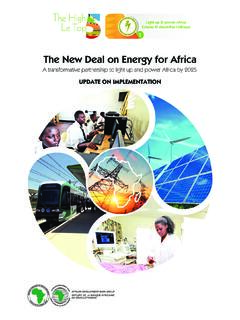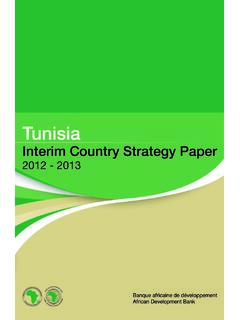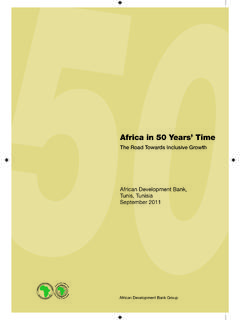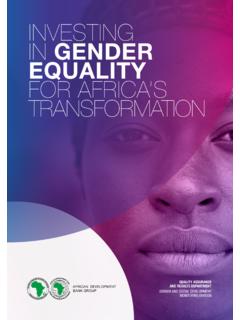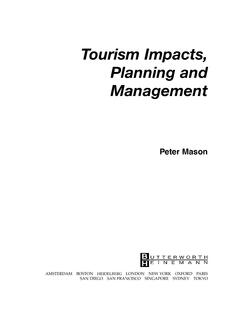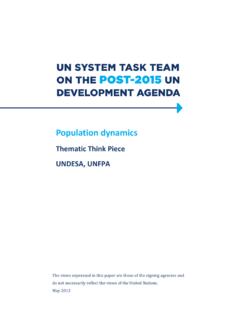Transcription of AFRICA’S INFRASTRUCTURE: GREAT POTENTIAL BUT LITTLE …
1 AFRICA'S. INFRASTRUCTURE: GREAT POTENTIAL . BUT LITTLE IMPACT ON. 3. INCLUSIVE GROWTH. KEY MESSAGES. A. frica must industrialize to end poverty and to generate employment for the 12 million young people who join its labor force every year. One of the key factors retarding industrialization has been the insufficient stock of productive infrastructure in power, water, and transport services that would allow firms to thrive in industries with strong comparative advantages. New estimates by the African Development Bank suggest that the continent's infrastructure needs amount to $130 170 billion a year, with a financing gap in the range $68 $108 billion. Those figures are far higher than previous estimates of $93 billion in annual needs and annual financing gaps of $31 billion published by Agence Fran aise de D veloppement and the World Bank.
2 Institutional investors such as insurance companies, pension funds, and sovereign wealth funds have more than $100 trillion in assets under management globally. A small fraction of the excess global savings and low-yield resources would be enough to plug Africa's financing gap and finance productive and profitable infrastructure. 63. Africa must industrialize to end poverty and to Economic decisions are rarely rational in the realm generate employment for the 12 million young of dreams, and without the interference of political people who join its labor force every year. One of subjectivities and irrationalities. the key factors retarding industrialization has been So, African countries facing mammoth infra- the insufficient stock of productive infrastructure structure needs have to change their focus and in power, water, and transport services that would strategy.
3 In fact, even if the continent had the allow firms to thrive in industries with strong com- resources, it should not devote them to financ- parative advantages. ing infrastructure. No country or region in world Despite the POTENTIAL long-term benefits, the history has ever had to fill its entire infrastructure share of resources allocated to infrastructure deficit before igniting and sustaining high rates was cut sharply by African governments and their of growth. Indeed, in the 19th century's industrial development partners in the 1980s and 1990s, revolution and the 20th century's miracle econo- thanks to the structural adjustment programs most mies, countries from several global regions grew African countries adopted under the so-called at high rates for long periods, while having wide Washington Consensus.
4 That partly explains Afri- infrastructure deficits. ca's current lag in infrastructure relative to other With an estimated infrastructure gap up to African countries regions. And while capital accumulation started $ billion a year, and urgent needs in health, need to accelerate to pick up again in the early 2000s, the pace has education, administrative capacity, and security, their investments in been too slow to close Africa's infrastructure gap. Africa has to attract private capital to accelerate New estimates by the African Development Bank the building of critical infrastructure needed to infrastructure, but (AfDB) suggest that the continent's infrastructure unleash its POTENTIAL .
5 In a smarter way needs amount to $130 $170 billion a year, with a African countries need to accelerate their financing gap in the range $ $ investments in infrastructure, but in a smarter But African countries do not need to fill these way. And they need to find new mechanisms and gaps before proceeding with their economic instruments to fund their most urgent needs . transformations. infrastructure and otherwise. African countries can The economic costs of Africa's insufficient jump directly into the global economy by building stock and poor quality of infrastructure are as well-targeted infrastructure to support competi- big for the continent as the size of the POTENTIAL tive industries and sectors in industrial parks and impacts of resolving the problem.
6 Funding infra- export-processing zones linked to global mar- structure in Africa and around the world should kets. Using their limited resources for infrastruc- not be an issue of financial resources. Beyond ture more wisely for new investments and main- the seemingly unlimited resources from the public tenance, all African countries can leverage these sector in advanced economies and central banks, zones to attract light manufacturing from more institutional investors such as insurance compa- advanced economies, as East Asian economies nies, pension funds, and sovereign wealth funds did in the 1960s and China in the 1980s. have around $100 trillion in assets under manage- By attracting foreign investment and firms, even ment the poorest African countries can improve their A small fraction of the excess global savings trade logistics, increase the knowledge and skills and low-yield resources would be enough to plug of local entrepreneurs, gain the confidence of inter- the financing gap and finance productive and prof- national buyers, and gradually make local firms itable infrastructure in the developing world.
7 That competitive. This strategy is already being used would boost aggregate demand, create employ- with GREAT success in Bangladesh, Cambodia, ment in poor and rich countries alike, and move Ethiopia, Mauritius, Rwanda, and Vietnam. The the world toward peace and prosperity. In ideal strategy need not be limited to traditional manufac- political circumstances, a global pact between turing but can also cover agriculture, services, and rich and poor nations would codify a grand bar- other activities. Africa is well placed to help boost gain based on infrastructure financing. But the the global economy. It is up to world leaders to put world does not have ideal political circumstances.
8 Forth the policy framework to make it happen. 64 A frica' s infrastructure INFRASTRUCTURE IS And in lowering transaction costs, infrastruc- CRITICAL FOR SUSTAINABLE ture fosters more efficient use of productive inputs GROWTH AND INCLUSIVE such as land, labor, and physical capital assets, DEVELOPMENT which translates into higher TFP, and expands the production frontier and profitable investment The positive impact of infrastructure on economic For example, reducing the cost growth and inclusive social development has been of broadband internet could foster the develop- well documented by researchers in several social ment of e-commerce and a digital economy. And science Infrastructure affects produc- the greater availability and reliability of infrastruc- tivity and output directly as part of GDP formation ture is poised to develop human capital through and as an input to the production function of other improved education and health services, which sectors.
9 And it does so indirectly by reducing should foster greater economic prosperity. Other transaction and other costs, thus allowing a more transmission channels include facilitating trade efficient use of conventional productive flows, stimulating aggregate demand, and improv- Poor energy quality, for example, can impose ing a country's attractiveness as an investment additional costs on firms such as idle workers, lost And over the short term, infrastruc- Infrastructure production, or damaged equipment. But modern ture projects create jobs during construction, also transport systems could increase manufacturing contributing to affects productivity competitiveness cheaply and quickly, moving raw Africa has a compelling case for accelerating and output directly materials to producers and manufactured goods infrastructure development.
10 First, it is a continent as part of GDP. to consumers. of small, open economies that will rely on trade High-quality infrastructure is essential for as the main engine of growth for the foreseeable formation and Africa to achieve the Sustainable Development future. For much of the period since World War II, as an input to Goals (SDGs) of the United Nations (UN), Agenda there has been an intellectual consensus that barri- the production of 2063 of the African Union (AU), and the High Five ers to market access tariffs, quotas, and nontariff Goals of the African Development Bank (AfDB). It measures disadvantaging foreign firms; safety and other sectors is needed for raising economic productivity and sanitary requirements; local content and the like.
